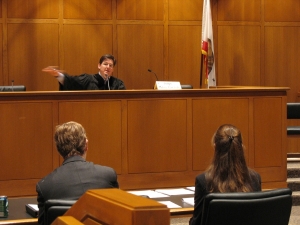By Chad M. Zimlich
Today, in the criminal case United States v. Avila, the Fourth Circuit considered the question of whether it was proper for the district court to have used a prior felony conviction from California in increasing the sentencing of Mario Vasquez Avila to thirty-seven months in prison for illegal reentry following an aggravated felony conviction, in violation of 8 U.S.C. § 1326(a) and (b)(2).
The Use of a First-Degree Burglary Conviction under CPC §§ 459 and 460(a)
When sentencing Avila, the District Court for the Western District of North Carolina found that a conviction under California Penal Code §§ 459 and 460(a), which details the elements for first-degree burglary, qualified for an eight-level sentencing enhancement under the United States Sentencing Guidelines. The section in question was §2L1.2(b)(1)(C), which provided for an increase for any defendant who previously was deported, or unlawfully remained in the United States, after a conviction for an aggravated felony. Avila contended that felony did not fall under the definition of an “aggravated felony.” Furthermore, he argued that the district court’s explanation of his sentence was “insufficient.” The Fourth Circuit disagreed on both issues.
Avila Had an Exceedingly Long History of Criminal Conduct
Avila had quite the record that followed him into court. Starting as far back as 1990, Avila entered the United States illegally and was subsequently arrested for shoplifting. After his first arrest, he voluntarily returned to Mexico. However, three years later, after illegally reentering, he was convicted of assault in California in 1993 and sentenced to a year in prison. After this, he was removed to Mexico, and immediately reentered and was arrested in 1994 when he plead guilty to first-degree burglary and sentenced to twelve years in prison. After his release immigration officials removed him again, and he reentered, this time arriving in North Carolina where he was twice convicted for driving while impaired, resulting in prison sentences of thirty days and six months, respectively.
Following this, Avila assaulted a woman and a police officer and was charged with two counts of simple assault and one count of communicating a threat. It was only then that immigration officials became aware of Avila’s presence in the North Carolina penal system. They interviewed him on March 23, 2012, where he lied claiming he was a United States citizen. A federal grand jury indicted him for illegal reentry following an aggravated felony conviction, in violation of 8 U.S.C. § 1326(a) and (b)(2), to which he pled guilty. It was in the sentencing for this crime that the main issue in this case arose. The secondary issue was that, in applying “an individualized approach,” the district court recounted Avila’s personal characteristics and criminal history and explained that they caused a concern for the safety of the public. Avila objected to this explanation and argued it was “insufficient.”
The California Burglary Conviction Qualifies as an Aggravated Felony
Judge Agee, writing the opinion of the Court, affirmed the district court’s holding that Avila’s 1994 conviction of first-degree burglary qualified as an aggravated felony under U.S.S.G. § 2L1.2(b)(1)(C).
A Crime of Violence Must Look to the Substantial Risk of Force
Avila argued that the California burglary conviction was not a crime of violence, and in doing so relied on the elements of the crime. His argument relied on the fact that the California statute lacked an element of an unlawful or unprivileged entry, and he further argued that such a definition was read to be as broad as to include shoplifting. A “crime of violence” under 18 U.S.C. § 16 is defined as “(a) an offense that has as an element the use, attempted use, or threatened use of physical force against the person or property of another, or (b) any other offense that is a felony and that, by its nature, involves a substantial risk that physical force against the person or property of another may be used in the course of committing the offense.” The Fourth Circuit determined it needed to look no further than to the Supreme Court’s decision in Leocal v. Ashcroft, where it was explained that “[Section] 16 relates . . . to the risk that the use of physical force against another might be required in committing a crime . . . [B]urglary, by its nature, involves a substantial risk that the burglar will use force against a victim in completing the crime.” Additionally, other courts have come to this same conclusion with California’s burglary statute.
The Fourth Circuit also distinguishes this case from that in Descamps v. United States, as that case dealt with a provision in the Armed Career Criminals Act, which did not contain a roster of enumerated offenses or list generic burglary as a qualifying crime. Instead, §16(b) speaks in descriptive terms of felonies that carry a substantial risk that force will be used. Because of this, the “crime of violence” definition was not restricted to generic burglary.
As to the claim that lacking an element of unlawful or unprivileged entry caused the definition to include shoplifting, the Fourth Circuit easily dismissed it, noting, “first-degree burglary requires entry into an inhabited dwelling.”
Avila’s Argument that His Sentence Wasn’t Sufficiently Individualized Holds No Weight
The Fourth Circuit also found that the district court’s explanation of its sentence was more than sufficient to preclude a finding of error. It reiterated that the explanation need not be exhaustive, merely that it be “sufficient ‘to satisfy the appellate court that [the district court] has considered the parties’ arguments and has a reasoned basis for exercising [its] own legal decisionmaking authority.” The district court had expressly stated that it considered Avila’s history and characteristics as a concern on the part of the Court for the “safety of the public.” Additionally, the Fourth Circuit rejected any kind of argument that the district court erred by failing to address his argument for a below-guidelines sentence, stating that Avila failed to explain in his brief what arguments the district court did not consider.
First-Degree Burglary Is a Crime of Violence
First-degree burglary, as defined in California Penal Code §§ 459 and 460(a), is a crime of violence within the meaning of 18 U.S.C. § 16(b) and therefore qualifies as an aggravated felony. Accordingly, the district court correctly applied the eight-level enhancement under U.S.S.G. § 2L1.2(b)(1)(C) when it calculated Avila’s sentence.












